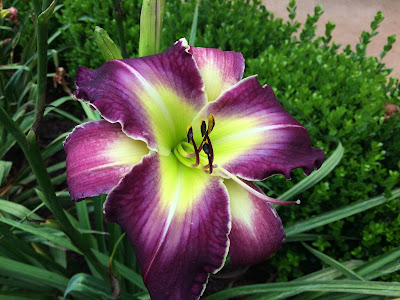So at our last meeting at the Waywood Acres garden (in the rain/sun) we talked about hybridizing and how we might cross daylilies to get seed that produces new plants that might possess the best attributes of each parent. Of course rain does not promote hybridizing and release of pollen so we just talked a little about it and did a quick demonstration. Here is a recap and review for those that couldn't attend. Above you see two potential parents that have desirable characteristics. One has wonderful branching and bud count and the other has a beautiful rich color and flower shape. My goal is to produce offspring that have both. Hold on a second, in the garden we looked at flowers and talked about ploidy (the number of chromosomes). Remember, diploid plants (22 chromosomes) and tetraploid (2 X chromosomes or 44) plants. For hybridizing purposes you cross diploids with diploids and tetraploids with tetraploids. You can't cross diploids and tetraploids. You know ploidy from the registration information provided by the hybridizer. All named varieties can be found at http://www.daylilydatabase.org/. Fortunately I know both of these daylilies are tetraploids. So if I pollinate one with the other I will likely produce seeds.
Next we talked flower anatomy. Remember your flower parts? The male parts, are the stamen, made up of filament and anthers (that hold the pollen), and female parts are the pistil made up of stigma, style, ovaries and ovules. Below you see how a hybridizer pollinates a flower. You simply remove the stamen of one flower (the anther, orange with fluffy pollen) and you simply tap it on the end of the pistil. The very tip of the pistil is the stigma and will be sticky and moist and after you tap it with the stamen, it usually will remain orange as the pollen will stick to it. I find that the pollen is best after 10:00 am in the morning in my garden and the stigma glistens with moisture around the same time. This can be highly variable because of humidity, sunshine, and shading though and I know folks who pollinate flowers early in the morning and late into the afternoon. You will have to try and see for yourself what works best in your garden. Its super easy.
You can cross both ways. The pollen of one flower on the stigma of the other. You should make notes to keep track of what crosses you produced. Some people put tags on the flower of the pollen parent they used in the cross. When listing your crosses, the female name always goes first and is written as female x male. The female will be the one that produces the pod (pod parent) and where the seed comes from. The day after pollination the flower will be wilted and mushy. Do not pull the flower off, just let it dry up on the scape. If the cross was successful you will notice that at the base of the dried flower a seed pod will begin to swell and eventually the dried flower will fall off.
In the picture above are two seedpods made on different days (thats why one is bigger than the other). Nothing to do now but wait! The pods will increase in size and mature. In about 3-4 weeks the pods will fade in green color and look brownish. Leave the seedpods on the scape until they are fully mature. The pod will begin to crack on the very top. You might be able to see the black seeds hiding within. At that point you can crack the pods and empty the seeds out (could be 3-25 seeds or more). They should be shiny and black. I make labels with the cross (female x male) and put the seeds and label in a sealed ziploc bag and stick them in the crisper draw of the fridge for a couple weeks. I sow the seeds as you would any other seeds in 1 gallon pots. I try to keep all the seeds from a pod in the same pot. For me, I pollinate in May, I harvest seeds in mid-late June, they go in the fridge for July and I plant seeds in pots by August 1st. They then go in the garden by September in numbered rows. If we have a warm winter, some will bloom the next spring but typically its the following spring when they all bloom.
There is nothing like going out to see what you've created. Everyone says its like opening Christmas presents and its true. Its a fun and exciting hobby and who knows, you might create some amazing daylilies to share!!! The photo below is the best cross I have had bloom this year (Papa goose x Green Arrow).









Comments
Post a Comment